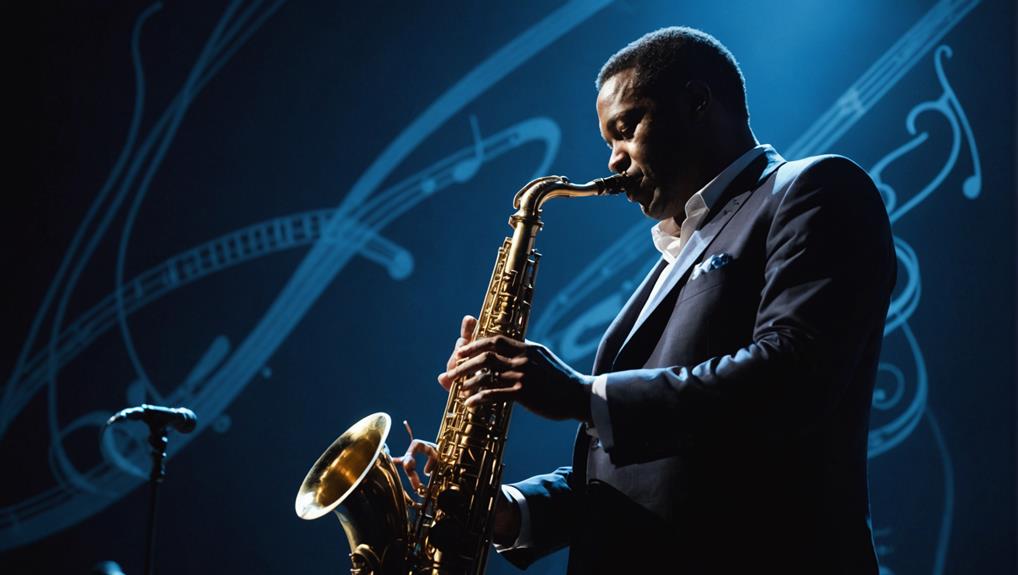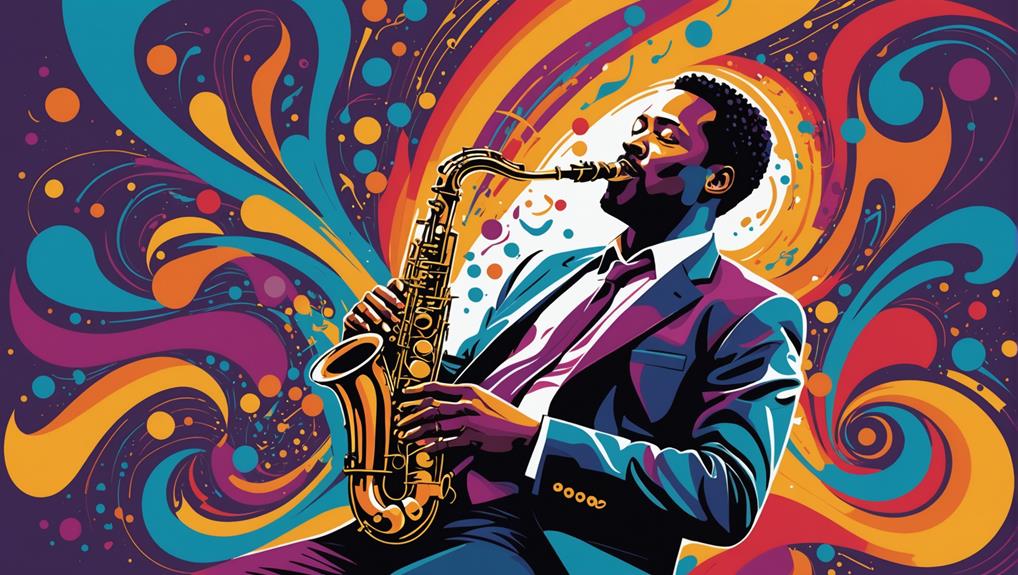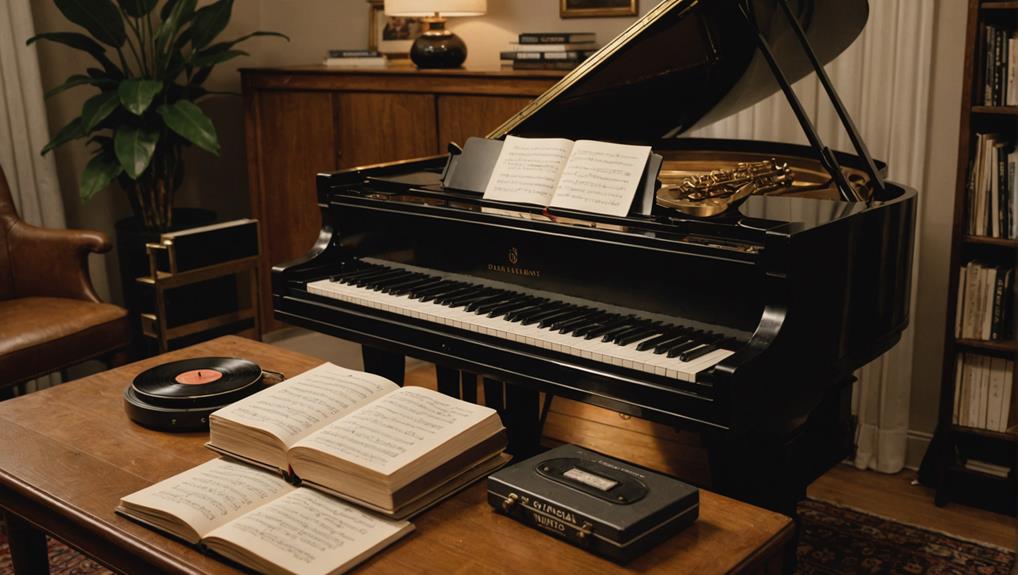Just as a painter must understand the principles of color and brushwork to create a masterpiece, you, as a recording artist, require a grasp of music theory to sculpt the airwaves with your sonic creations.
Music theory isn’t just an academic exercise; it’s a toolkit that enables you to navigate the complex world of melody, harmony, and rhythm with confidence and precision. It’s the language that lets you articulate your musical vision to fellow musicians, producers, and engineers.
Now, consider how a deeper knowledge of this language could transform your approach to songwriting, performance, and collaboration. Imagine the doors that could open if you could dissect and harness the power of chord progressions, modal interchange, or polyrhythmic structures at will.
As your journey unfolds, you’ll find that the depths of music theory are vast and rich with potential—potential that could elevate your artistry to new heights. But what specific elements of music theory are indispensable for you, and how can they be applied to ensure your recordings stand out in a sea of digital noise?
Let’s set the stage for a harmonious exploration.
Key Takeaways
- Understanding musical elements such as melody, harmony, and rhythm is essential for recording artists to effectively communicate their musical ideas.
- Music theory provides the knowledge and tools for recording artists to adapt to different genres’ rhythmic structures and create compelling beats.
- Familiarity with scales and chord progressions allows recording artists to craft catchy melodies, add emotional qualities to improvisation, and navigate the musical landscape with confidence.
- Song structures and dynamics, including the use of verses, choruses, bridges, and variations in dynamics and phrasing, are crucial for engaging listeners and creating memorable and impactful music.
Understanding Melody and Harmony

While melody crafts the distinct tune you hum along to, harmony enriches it by layering pitches that simultaneously support and enhance the melodic line. As a recording artist, you’re not just creating hooks; you’re exploring melodic intervals, the steps and leaps between notes that make a melody move and breathe. Each interval—whether it’s a soothing third or a daring tritone—carries emotional weight and narrative direction.
On the flip side, harmony provides context. It’s the architectural framework within which your melody resides. Chords map out the harmonic landscape, and it’s within this terrain that harmonic tension and resolution play out. Tension is the dissonance, the unresolved chord progressions that create a sense of anticipation or unrest. Resolution is the consonance, the satisfying release when a chord sequence settles, fulfilling the listener’s unconscious expectations.
Understanding these concepts is critical for you to manipulate the emotional journey of your music. It’s the interplay between these melodic and harmonic elements that dictates whether a piece soars with elation or plunges into sorrow. Your grasp of melody and harmony is the toolkit for constructing complex, innovative soundscapes that resonate with your audience’s deepest sensibilities.
Learning Rhythm and Beat
Diving into rhythm and beat, you’ll discover the pulse that gives music its lifeblood, guiding how each note is expressed in time and space. As a recording artist, your command over rhythm involves mastering elements such as pulse, tempo, meter, note duration, articulation, and syncopation. Music theory lays out the framework for understanding these components, essential for interpreting and performing songs with precision.
Grasping the role of rhythm in different genres of music allows you to navigate through diverse musical landscapes. Whether you’re dealing with the complex syncopation of jazz or the steady backbeat of rock, music theory equips you with the knowledge to adapt and thrive within each genre’s rhythmic structure. Furthermore, rhythmic improvisation techniques are pivotal for innovation, enabling you to create fresh, compelling beats that resonate with your audience.
Your musicality is amplified as you learn to articulate rhythms accurately. This precision in performance isn’t just about keeping time; it’s about conveying emotion and intention through the dynamic use of rhythm. Thus, a thorough understanding of rhythm and beat through music theory is indispensable—it’s the scaffold upon which your creative expression is built and showcased.
Reading and Writing Notation
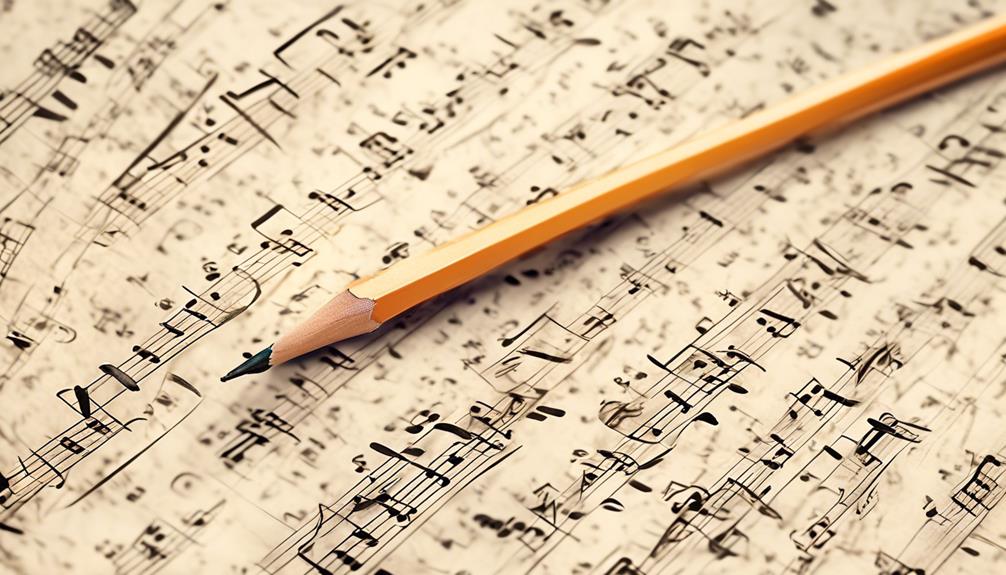
As you approach reading and writing notation, you’ll first need to grasp sheet music basics, recognizing how symbols translate to musical sounds. Notation serves as a crucial tool for effective communication, enabling you to share and interpret musical ideas with precision and clarity.
Understanding Sheet Music Basics
To effectively communicate musical ideas, it’s essential to grasp the fundamentals of sheet music, which serve as the blueprint for translating written symbols into audible sounds. Reading sheet music isn’t just about recognizing notes; it involves mastering key signatures and understanding their role in establishing the tonality of a piece.
Here’s what you need to know:
- Staff and Notes
- Five lines and four spaces
- Note shapes indicate pitch and duration
- Clefs
- Treble or bass define pitch range
- Key Signatures and Time Signatures
- Key signatures determine the scale and accidentals
- Time signatures outline the rhythmic structure
As you dive deeper into music theory, you’ll find that these components are vital in crafting and interpreting intricate musical compositions.
Notation for Effective Communication
Mastering the art of reading and writing music notation empowers you, the recording artist, to accurately convey and interpret the rich language of musical compositions. This skill is crucial for ensuring that the nuances of musical expression are clearly communicated, whether you’re preserving a fleeting idea or collaborating with other musicians.
Notation serves as a precise tool for notation interpretation, allowing you to delve into the intricacies of rhythm, melody, harmony, and dynamics. It’s the blueprint for musical architecture, providing a foundation upon which innovative and complex structures can be built.
As you advance in your proficiency, you’ll find that your ability to interpret and express music through notation becomes second nature, enhancing your creative and performative capabilities.
Composing With Musical Symbols
Building on the fundamental skills of reading and writing music notation, you’ll find that composing with musical symbols is a logical next step in your journey as a recording artist. As you dive into composing techniques, it’s crucial to grasp the advanced notation techniques that allow for nuanced expression and precise communication of your musical ideas.
Understanding Intervals:
- Half Steps: The smallest pitch interval used to create tension and resolution.
- Whole Steps: Combine to form the scales that underpin melodic and harmonic structures.
Utilizing Musical Notation:
- Pitch: Notated with letters (A-G) and accidentals (♯ and ♭).
- Rhythm and Dynamics: Dictate the flow and intensity of the composition.
These elements are the building blocks for innovative composing, enabling you to articulate the exact texture and dynamics your music requires.
Constructing Chord Progressions

Understanding the construction of chord progressions is pivotal for recording artists, as it lays the harmonic groundwork that guides the emotional and structural direction of their music. When you engage in chord progression analysis, you’re not just identifying the chords used; you’re also discerning their purpose and interrelations within the context of the piece. This analytical approach enables you to predict listener responses and craft progressions that resonate deeply.
Chord substitution techniques offer a pathway to innovation, allowing you to replace familiar chords with less conventional ones, thus adding color and complexity to your music. By understanding the functional relationships between chords, you can manipulate the emotional contour of your work, creating a unique sonic identity.
Here’s a brief table to illustrate chord functions and potential substitutions:
| Chord Function | Chord Substitution Example |
|---|---|
| Tonic (I) | vi (minor sixth) |
| Subdominant (IV) | ii (minor second) |
| Dominant (V) | vii° (diminished seventh) |
| Pre-Dominant (ii) | IV (major fourth) |
Embrace these techniques to cultivate a distinctive harmonic language. The technical mastery of chord progression construction will empower you to convey your artistic vision with precision and emotional depth.
Exploring Musical Scales
Exploring various musical scales equips you with the tools to craft melodies and harmonies that evoke specific emotional tones and atmospheres in your compositions. As you delve into the patterns and intervals that make up these scales, you gain the ability to analyze the emotional impact of different scales, creating a unique sonic palette for each project.
Consider the following points as you explore musical scales:
- Understanding Scales
- Major scales often convey brightness and joy
- Minor scales can evoke sadness or introspection
Application in Music
- Pentatonic scales are versatile for crafting catchy melodies
- Blues scales add soulful and emotive qualities to improvisation
Exploring improvisation techniques becomes significantly more intuitive when you’re familiar with the scales pertinent to the style you’re playing. Mastery of scales enhances your ability to navigate the musical landscape, giving you the confidence to innovate and experiment with new sounds.
Applying Song Structures

As you tackle song structures, you’ll find that mastering the dynamics between verses and choruses is crucial for maintaining listener engagement.
Crafting memorable bridges isn’t just about a catchy tune; it’s about creating a pivotal moment that enhances the overall narrative of your song.
Additionally, exploring the potential of intros and outros can set the tone and frame your musical work, leaving a lasting impression on your audience.
Understanding Verse-Chorus Dynamics
To effectively engage your audience, it’s crucial to master the dynamics between verses and choruses, as they form the backbone of most contemporary song structures.
- Analyzing popular songs
- How do verses set up the story?
- What makes the chorus memorable?
- Examining the impact of verse-chorus dynamics on listener engagement
- What creates the emotional highs and lows?
- How does repetition build familiarity?
Verses often weave the narrative, setting an emotional stage for the chorus to deliver the central theme with a potent emotional hook. The interplay between these sections is instrumental in captivating your listeners.
As you dissect and apply these principles to your music, you innovate within the medium, ensuring your songs resonate and linger in the minds of your audience.
Crafting Memorable Bridge Sections
Having mastered the verse-chorus interplay, it’s crucial for artists to also focus on crafting bridge sections that offer a refreshing departure and deepen the song’s narrative. This is where your innovative spirit merges with music theory to create a pivotal moment in your song through unique melodic phrasing and compelling lyrical storytelling.
| Element | Role in Bridge Crafting |
|---|---|
| Melodic Phrasing | Creates musical contrast and sustains listener interest. |
| Chord Progressions | Deviates from the norm to emphasize the bridge’s distinctiveness. |
| Lyrical Storytelling | Introduces new perspectives or escalates the song’s emotional trajectory. |
| Dynamics | Shifts in intensity can highlight the bridge’s importance. |
| Rhythmic Variation | Offers an unexpected twist to maintain engagement. |
Use these elements to dissect and construct bridges that not only stand out but also contribute significantly to your song’s overall impact.
Exploring Intro/Outro Possibilities
Begin your musical journey with an intro that captivates listeners’ attention, employing varying song structures to set the emotional tone of your track. As a recording artist, it’s crucial to master the art of:
- Exploring unique transitions
- Experiment with contrasting musical elements to forge a memorable intro.
- Consider how an unexpected intro can pique interest and foreshadow the song’s narrative.
- Utilizing dynamic contrast
- Design intros and outros that stand in stark relief to the main sections, emphasizing the song’s dynamics.
- Use these sections to subtly introduce or reprise motifs, enhancing overall cohesion.
Innovate within your intros and outros to create a sense of anticipation and resolution, ensuring your song resonates with a sense of completeness and leaves a lasting impression.
Orchestrating and Arranging Music
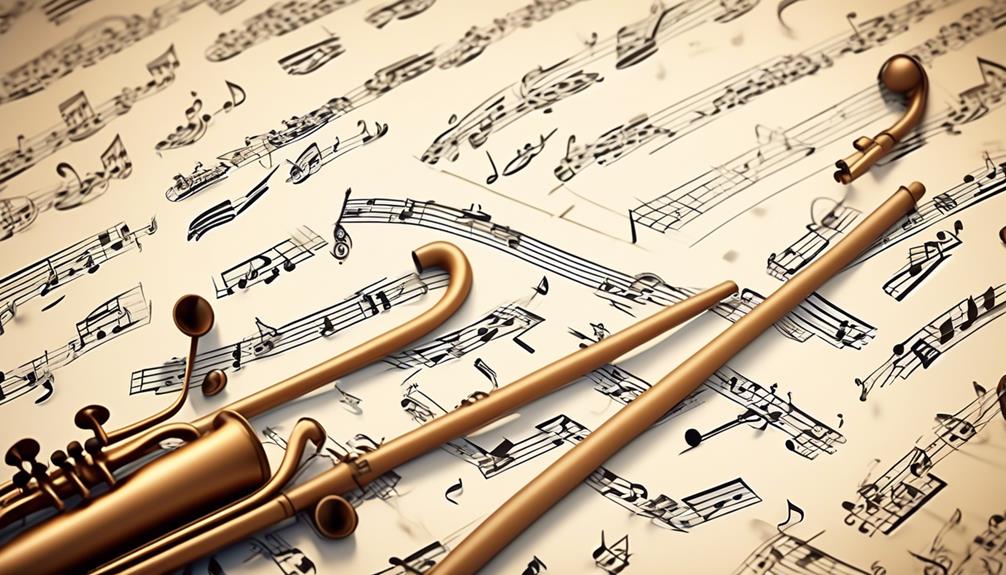
Understanding the principles of orchestrating and arranging music is crucial for recording artists to effectively translate their musical visions into dynamic, full-fledged compositions. Your instrumentation choices play a pivotal role in the texture and timbre of your work, shaping the listener’s experience. Each instrument brings a unique color to the sonic palette, and your ability to blend and contrast these colors determines the vibrancy of the auditory landscape you’re painting.
Dynamics control is equally essential; it’s the ebb and flow of musical storytelling. You must master the art of building tension and release, using volume and intensity to guide the emotional journey of your audience. Think of dynamics as a three-dimensional space in which your music breathes, grows, and evolves.
As you arrange, consider how each element interacts, ensuring melodies don’t get lost in a sea of harmonies and that rhythms interlock to propel the piece forward. Your analytical skills will enable you to dissect complex scores and innovate within your arrangements. Stay ahead of the curve by experimenting with unconventional sounds and structures. Remember, the most groundbreaking music often emerges from the intersection of disciplined theory and daring experimentation.
Frequently Asked Questions
Do Singers Need to Know Music Theory?
You’ll benefit from music theory to refine your vocal techniques and enhance melodic intuition, ensuring you’re not just innovative but also technically sound in your singing endeavors.
Is Music Theory Necessary for Songwriting?
You don’t strictly need music theory for songwriting, but it sharpens your composition instincts and enriches melodic experimentation, fostering innovation in your work. It’s a technical edge in a highly competitive, creative field.
Do Rockstars Know Music Theory?
You’re exploring if rockstars grasp music theory, debunking theory myths while recognizing many rely on intuitive playing that harmonizes with technical understanding to innovate and push musical boundaries.
Do You Need Music Theory to Be a Producer?
As a producer, you don’t strictly need music theory, but it aids in genre flexibility and beat construction, enhancing your creative toolbox for innovative soundscapes and harmonically rich arrangements.
Conclusion
In conclusion, as a recording artist, you’ll find that grasping music theory sharpens your creative edge. You’ll compose with clarity, communicate with precision, and adapt your style across genres.
Mastering melody, harmony, rhythm, and notation isn’t just academic—it’s practical. It underpins your chord progressions, scales, and song structures, empowering you to orchestrate with confidence.
Embrace music theory; it’s the toolkit that’ll elevate your artistry and enhance your musical conversations.


